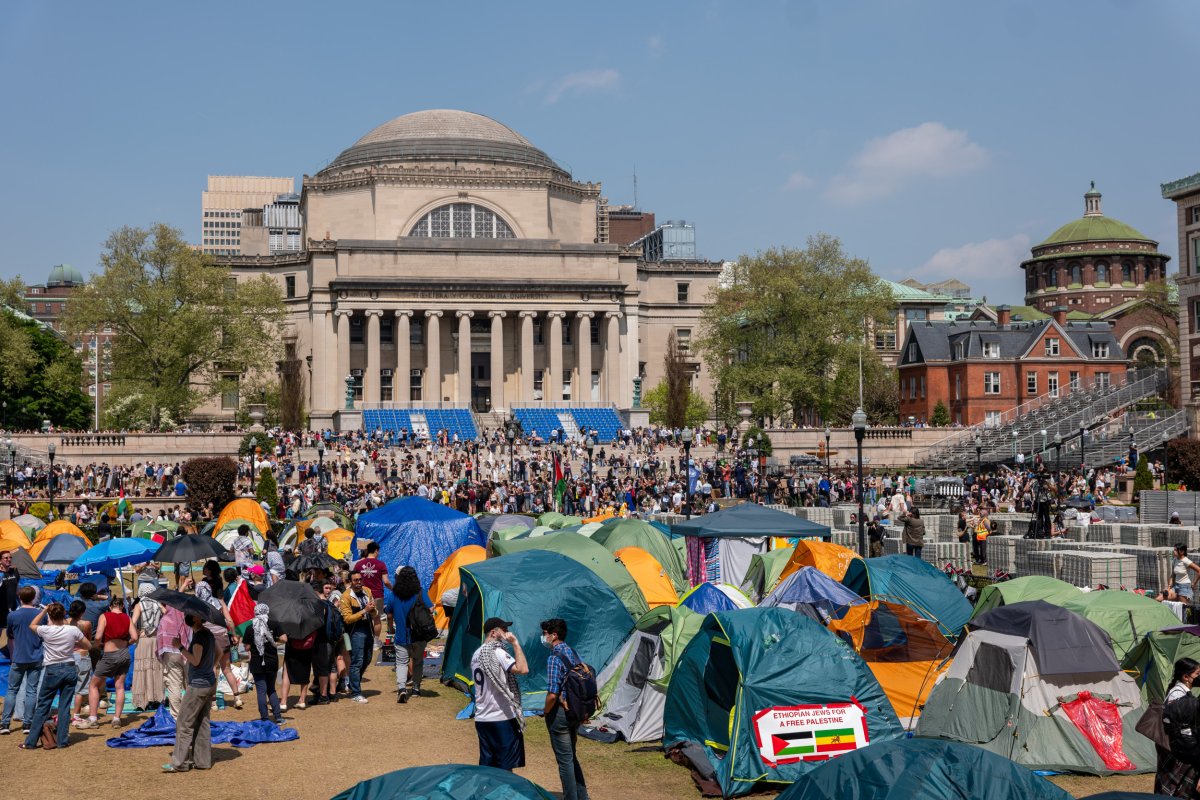Colleges and universities targeted by President Donald Trump have faced calls to pull from their endowments to offset federal funding cuts if they don’t give into his demands—but experts say it isn’t that easy.
Why It Matters
Harvard University in Cambridge, Massachusetts, on Monday said it would defy the Trump administration’s demands on missives including an end to its diversity, equity and inclusion (DEI) programs and reforming student discipline policies. The federal government then announced it would freeze more than $2.2 billion in grants and $60 million in contracts to the university.
Trump has taken aim at colleges and universities over their handling of pro-Palestinian protests that began last year. The administration accused university leaders of not doing enough to push back against antisemitism. Critics, however, have said the administration is conflating antisemitism with criticism of Israel, and that its efforts to target these universities violates free-speech rights.
While Harvard is resisting Trump’s demands, Columbia University took a different approach, agreeing to implement measures like banning masks concealing someone’s identity and hiring 36 campus officers “who will have the ability to remove individuals from campus and/or arrest them when appropriate.”
What To Know
As these universities deal with the potential loss of billions of dollars in federal funds, questions have arisen about why they don’t simply turn to their billion-dollar endowments to provide financial cushioning to allow them to defy Trump.
Former Harvard President Larry Summers is among those who have said universities should try drawing from their endowments if possible.
“They should make clear that their formidable financial endowments are not there to simply be envied or admired,” he wrote in a New York Times opinion piece. “Part of their function is to be drawn down in the face of emergencies, and covering federal funding lapses surely counts as one. Believe me, a former president of Harvard, when I say that ways can be found in an emergency to deploy even parts of the endowment that have been earmarked by their donors for other uses.”
But others say it’s not necessarily easy for universities to access those funds. Endowments are mostly tied up in nonliquid assets that were earmarked for very specific purchases, so universities can’t just use those funds as they please.
“Nonprofit endowments are not savings accounts or rainy day funds,” Liz Clark, vice president of policy and research for the National Association of College and University Business Officers (NACUBO) told Newsweek. “They are very different, and they are unique strategic finance tools. Endowments are managed in a way that those organizations can rely on them for support in the here-and-now, but also far into the foreseeable future.”
An endowment is a collection of thousands of contracts with donors who made contributions for specific purposes like financial aid of scholarships, she said. They also often promote scientific research and medical enterprises, she said.
The endowment is also intended to support these causes over time, meaning schools must manage donations by investing them in stocks, real estate or private equity to “deliver on that purpose today,” but also “be able to utilize decades from now and beyond,” according to Clark.
She also noted that universities have unique financial structures, so some may have reserve funds to tap into amid the D.C. “turbulence,” rather than going into the endowment.

Spencer Platt/Getty Images
If a university aims to change the means of endowment expenditure, it must go to donors or their representatives to begin the legal process to change its general purpose, Clark said.
“Then there’s the actual process of accessing liquid funds,” Clark said. “These funds are often invested in the stock market, potentially invested in real estate or are part of other complicated investment vehicles. Those can be very complicated to move from the investment position to cash.”
Colleges and universities can look to new funding sources, like state and local governments or the business community, to make up for lost federal funds, Clark said. If they’re unable to do so, they may need to “make tough decisions about what programs they can keep and those they cannot.”
Harvard is planning to issue $750 million of taxable bonds for “general corporate purposes” that would add to its $7.1 billion in debt, Reuters reported. A university spokesperson told Inside Higher Ed that the institution “regularly issues debt, largely to support its extensive capital initiatives,” and that planning for this began “months ago.”
Bruce Kimball, author of Wealth, Cost, and Price in American Higher Education: A Brief History, told Newsweek that universities pulling from their endowments “is never a sound idea.”
This is because the money generated by the endowment is meant to “support institution in perpetuity,” and contribute to schools’ long-term autonomy and flexibility, Kimball said, and that pulling from the endowment also has “many hidden costs in portfolio management.”
“Colleges and universities do not spend all their annual income because they re-invest a portion of that income in order to maintain the value of the endowment after inflation. Therefore it is possible for schools to raise the amount they spend in a given year to cover unexpected emergencies,” he said.
Harvard has the largest endowment of any college or university in the country, at nearly $52 billion, according to the 2024 NACUBO-Commonfund Study of Endowments, The study also found the median endowment was $243 million, and that nearly 30 percent of all colleges or universities that participated in the study have endowments of $100 million or less.
Only the universities with the largest endowments may have enough to cover the loss of federal funds, Kimball said.
Schools with smaller endowments dipping into the fund would imperil “the quality of their education, and even their long-term existence, would rapidly be threatened,” he said.
What People Are Saying
Harvard President Alan M. Garber wrote in a statement Monday: “The administration’s prescription goes beyond the power of the federal government. It violates Harvard’s First Amendment rights and exceeds the statutory limits of the government’s authority under Title VI. And it threatens our values as a private institution devoted to the pursuit, production, and dissemination of knowledge. No government—regardless of which party is in power—should dictate what private universities can teach, whom they can admit and hire, and which areas of study and inquiry they can pursue.”
Progressive activist and commentator Briahna Joy Gray on X: “What’s the point of having the biggest endowment in the world if you can’t do this? Good for Harvard.”
Trump posted to Truth Social on Tuesday: “Perhaps Harvard should lose its Tax Exempt Status and be Taxed as a Political Entity if it keeps pushing political, ideological, and terrorist inspired/supporting “Sickness?” Remember, Tax Exempt Status is totally contingent on acting in the PUBLIC INTEREST!”
What Happens Next
Several other colleges and universities are under investigation by the Trump administration as part of its anti-DEI efforts, and it has yet to be seen whether they will comply with Trump’s demands or refuse to do so as Harvard did.




